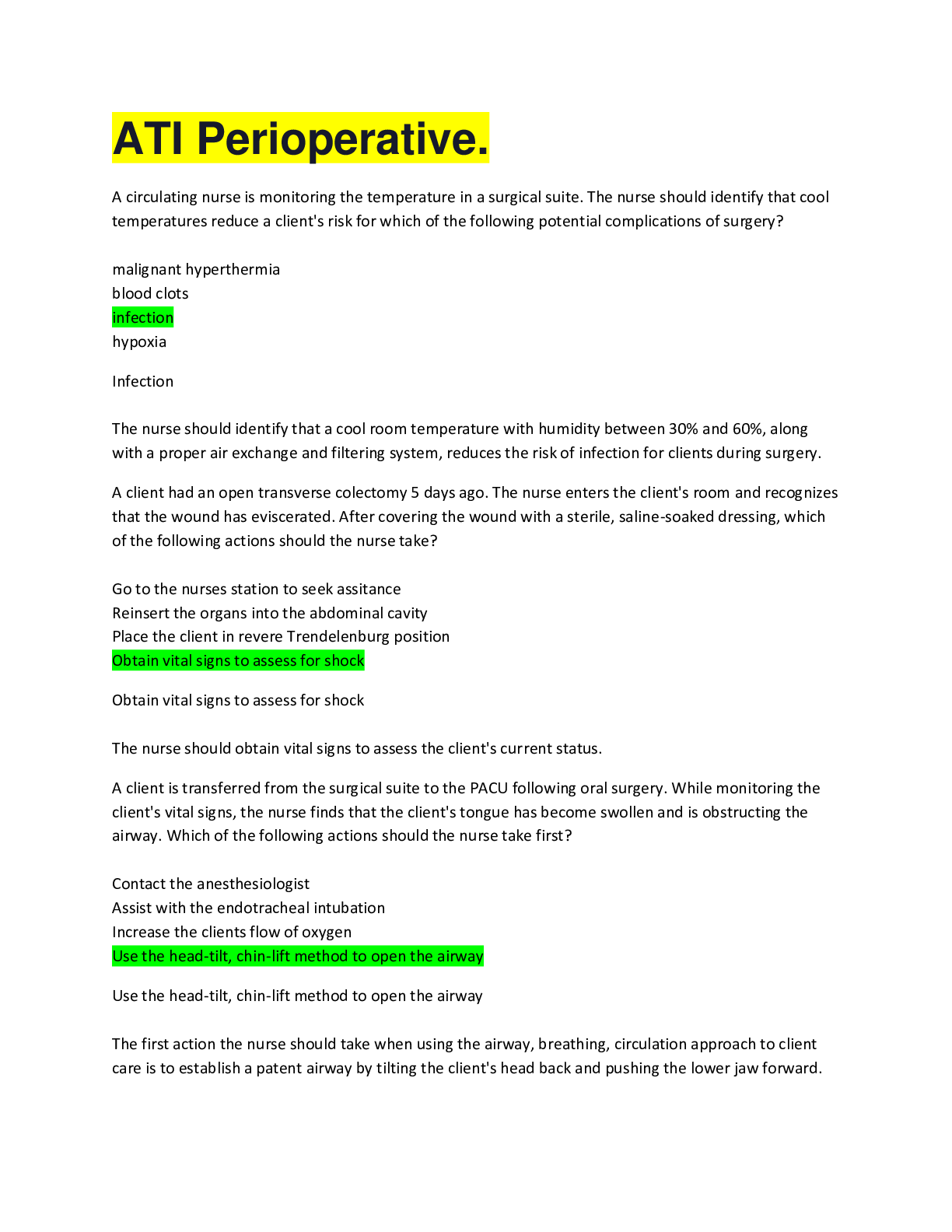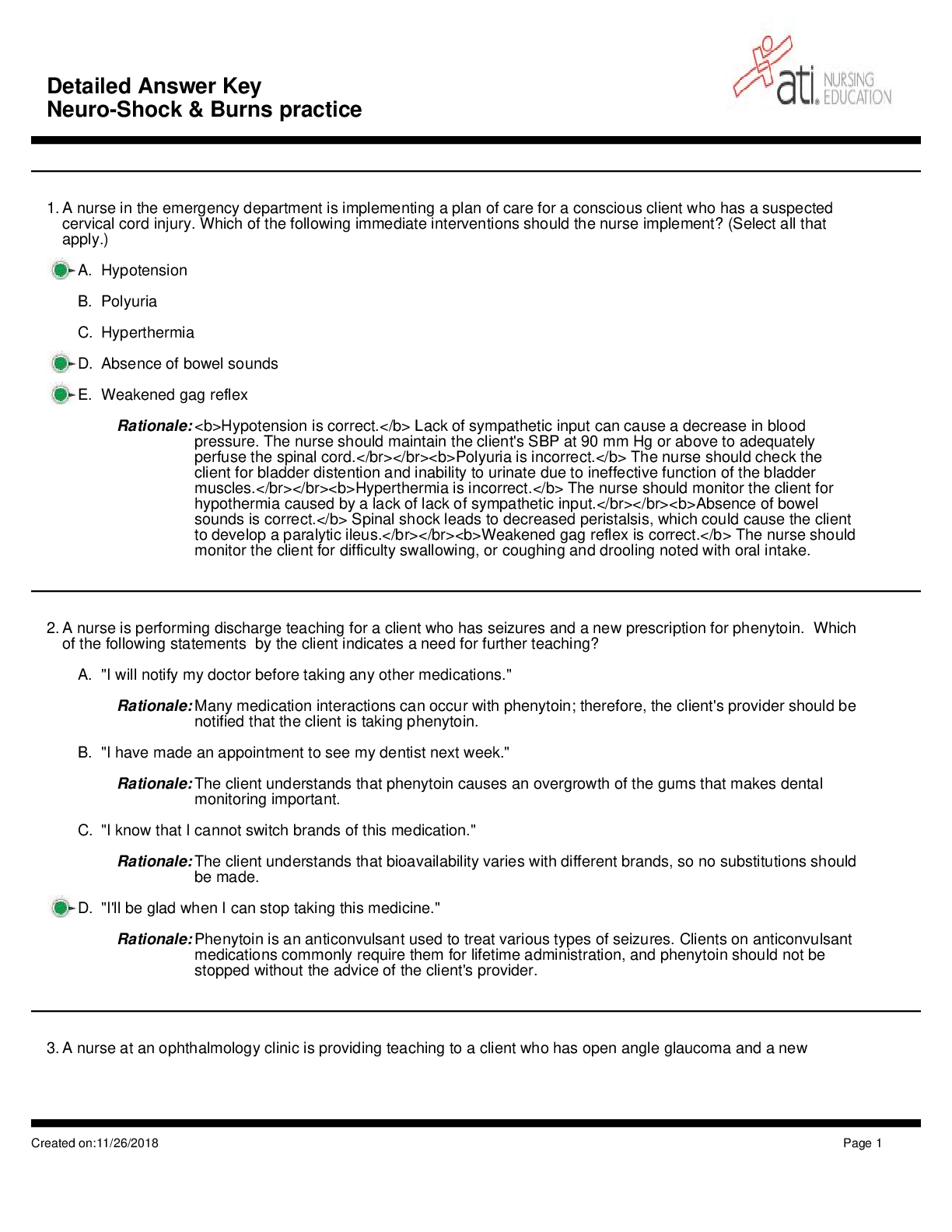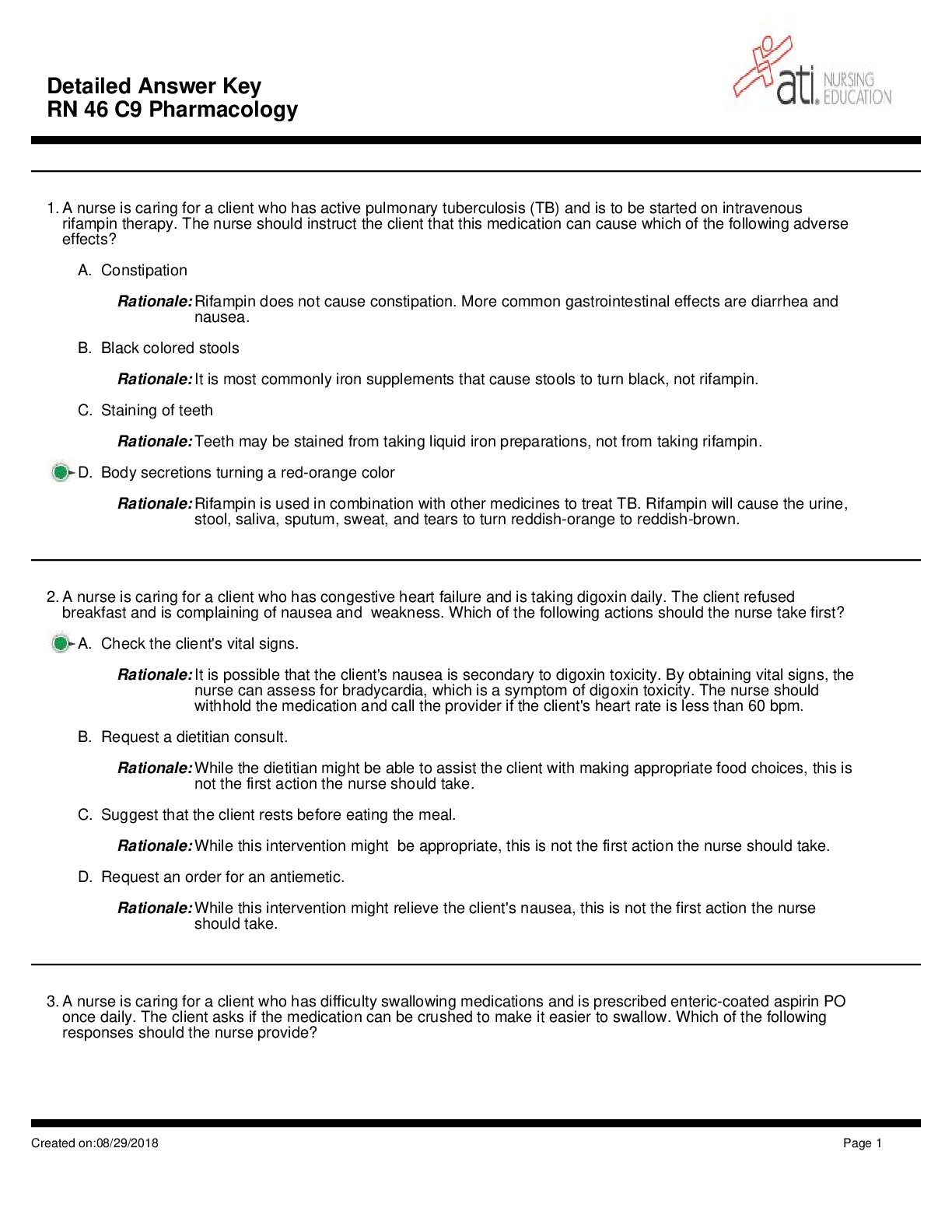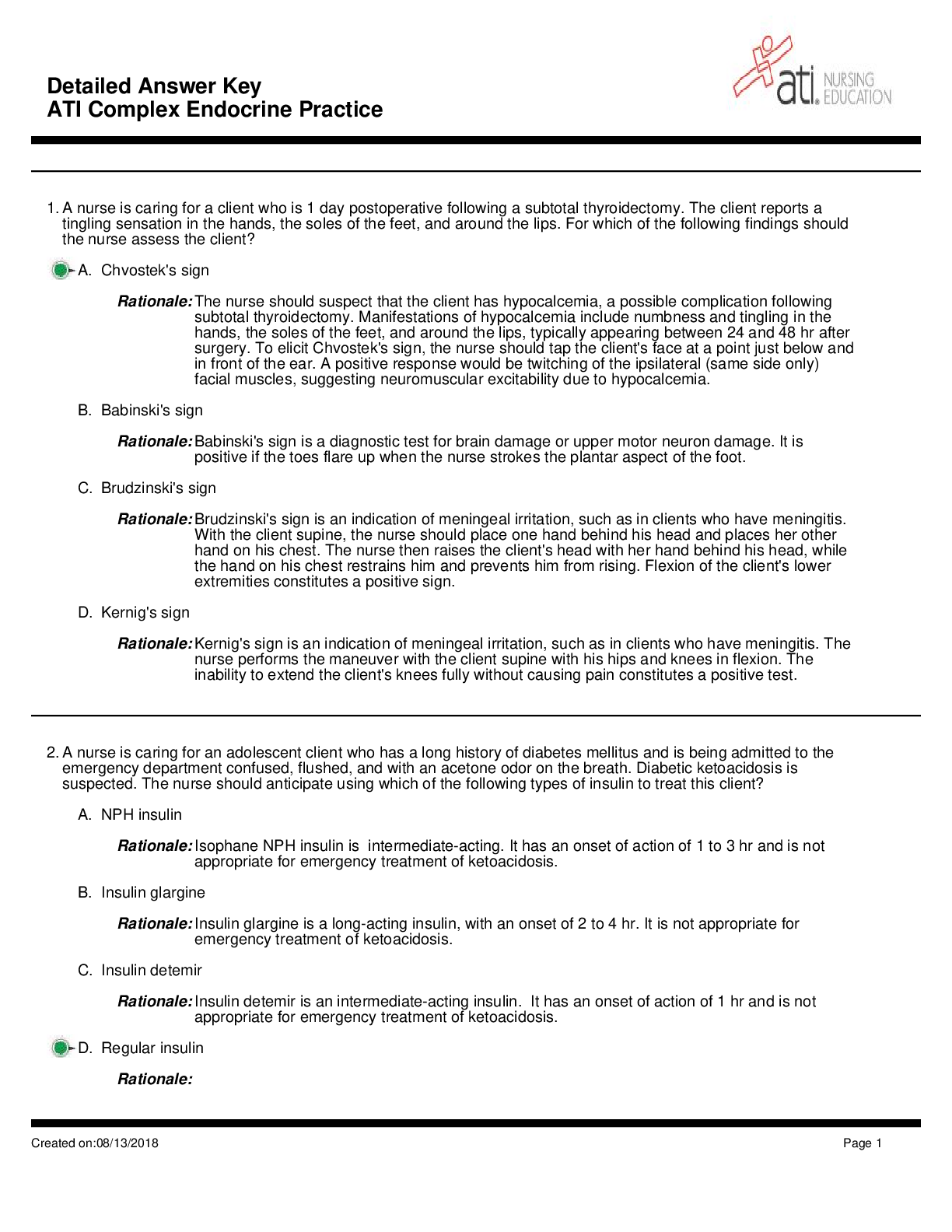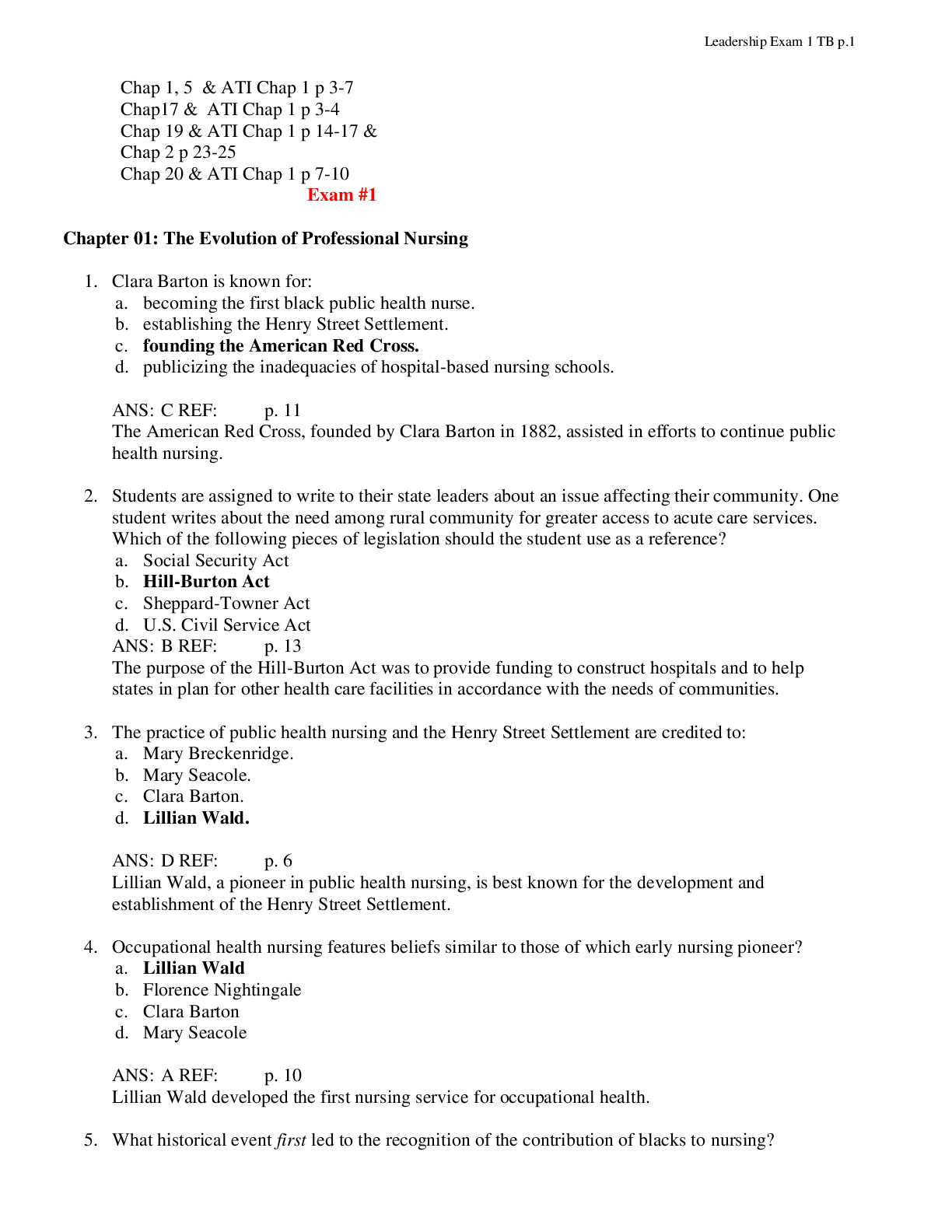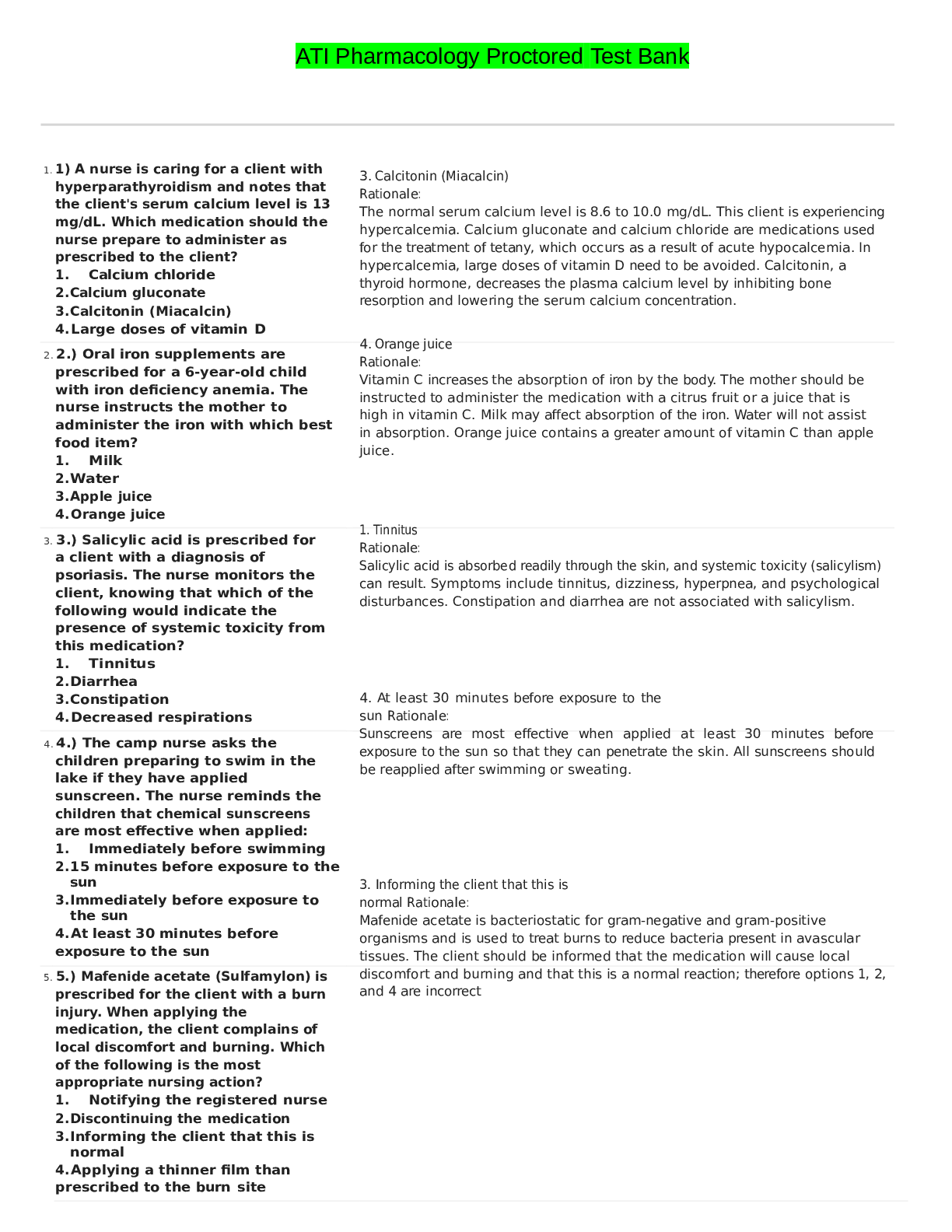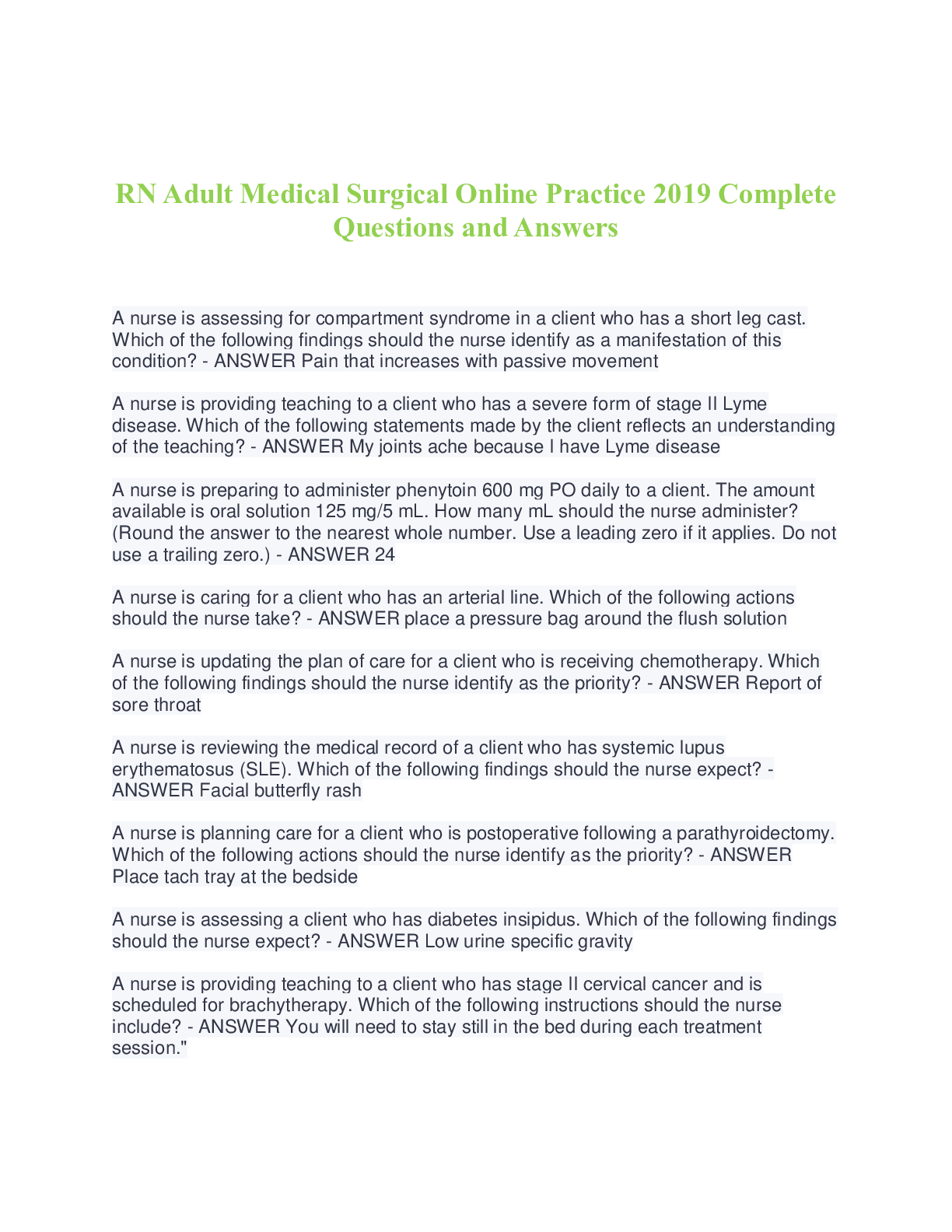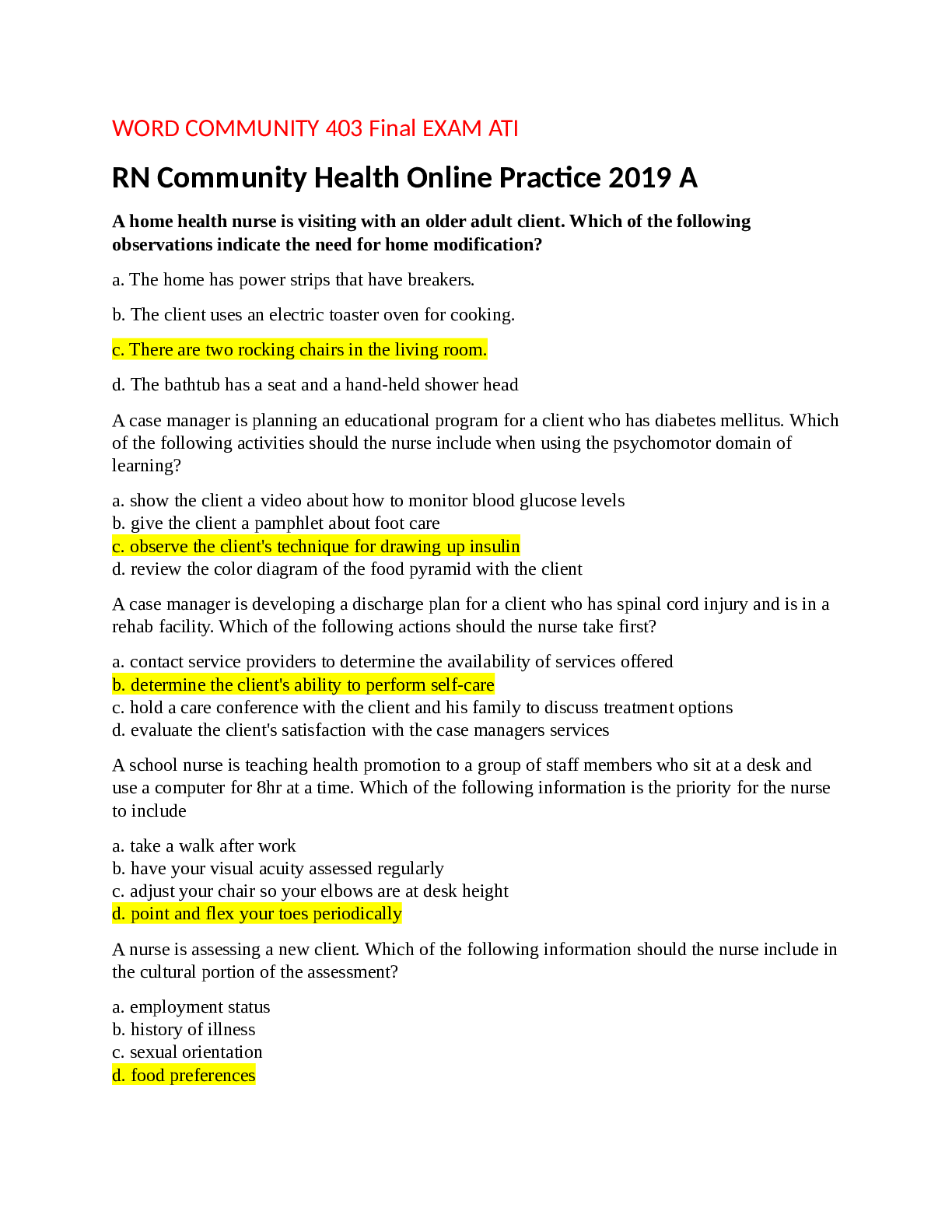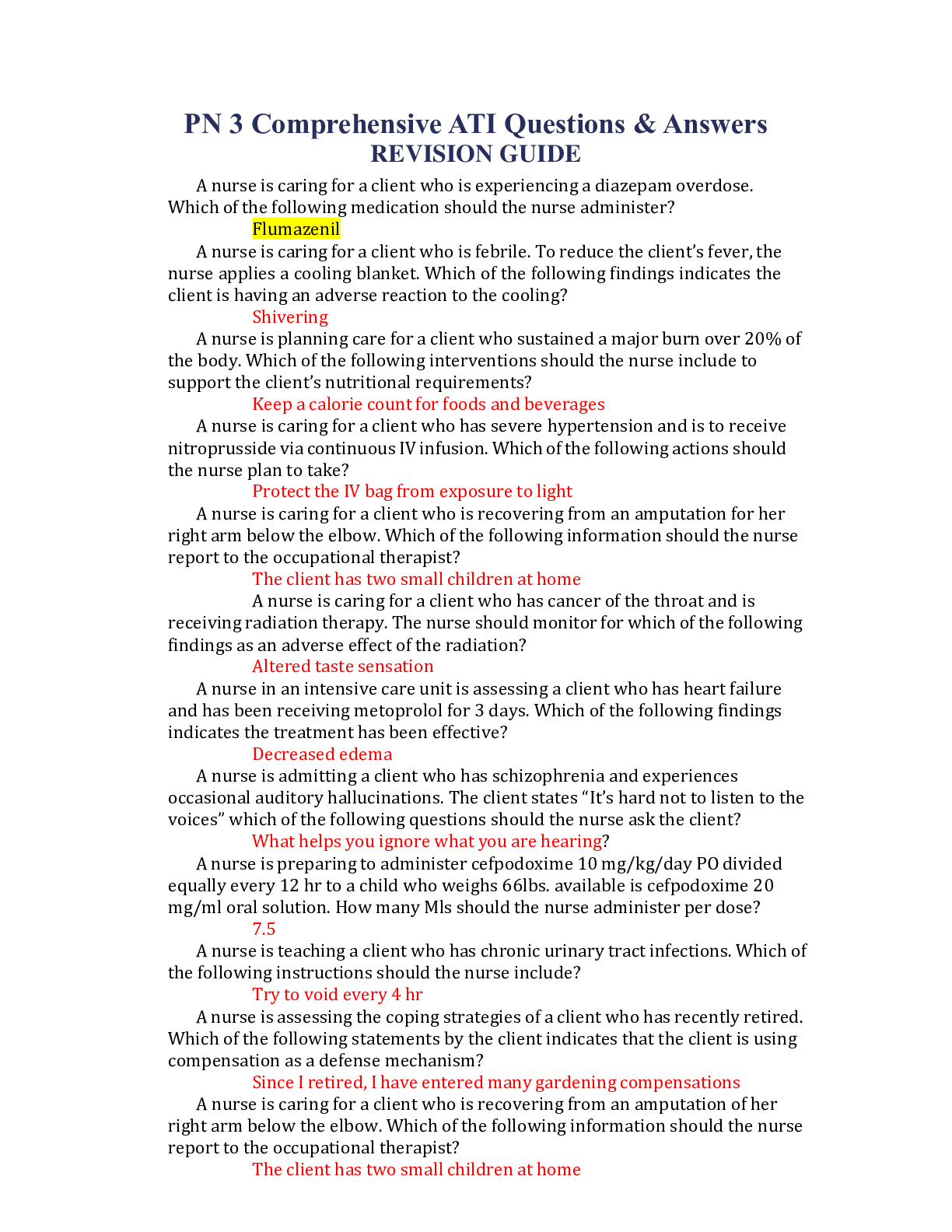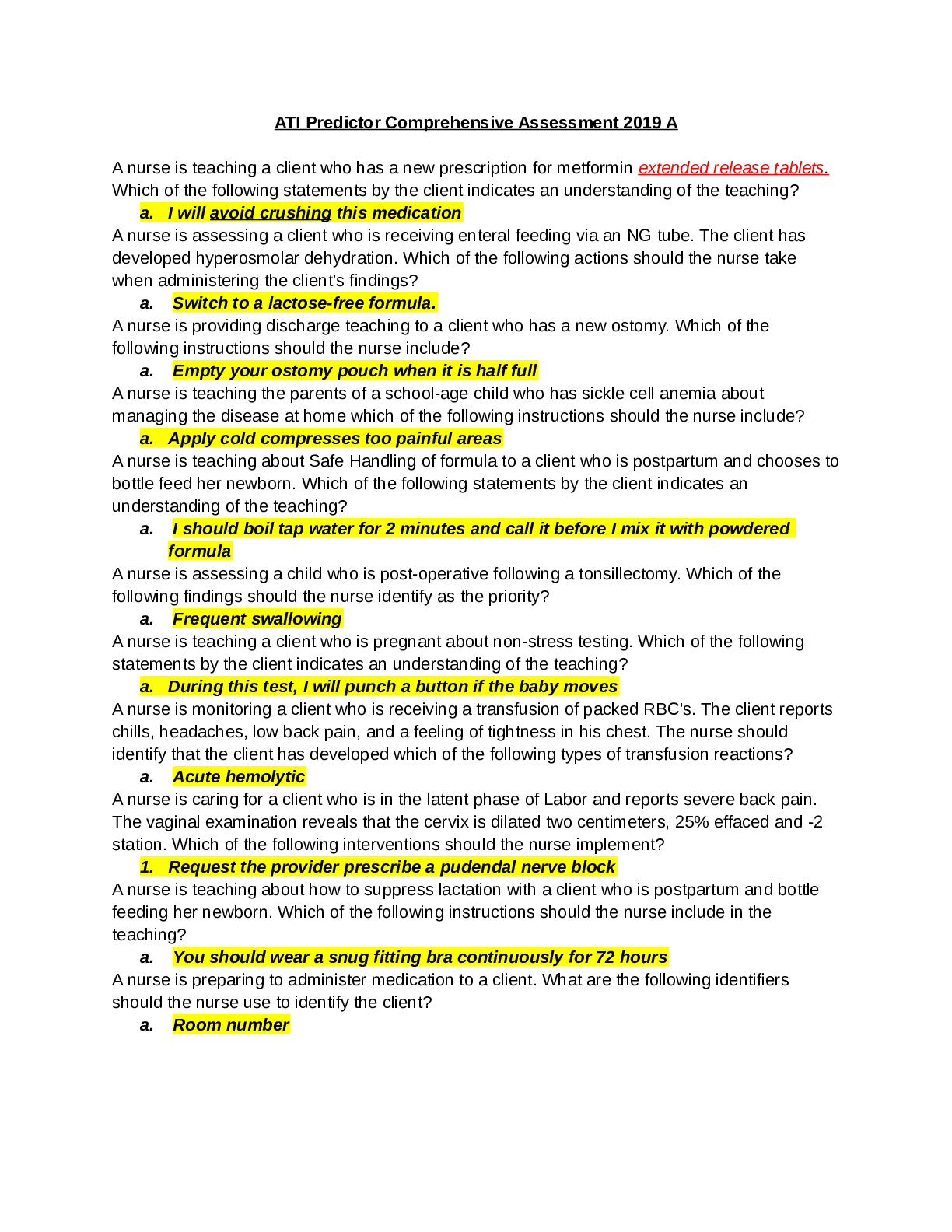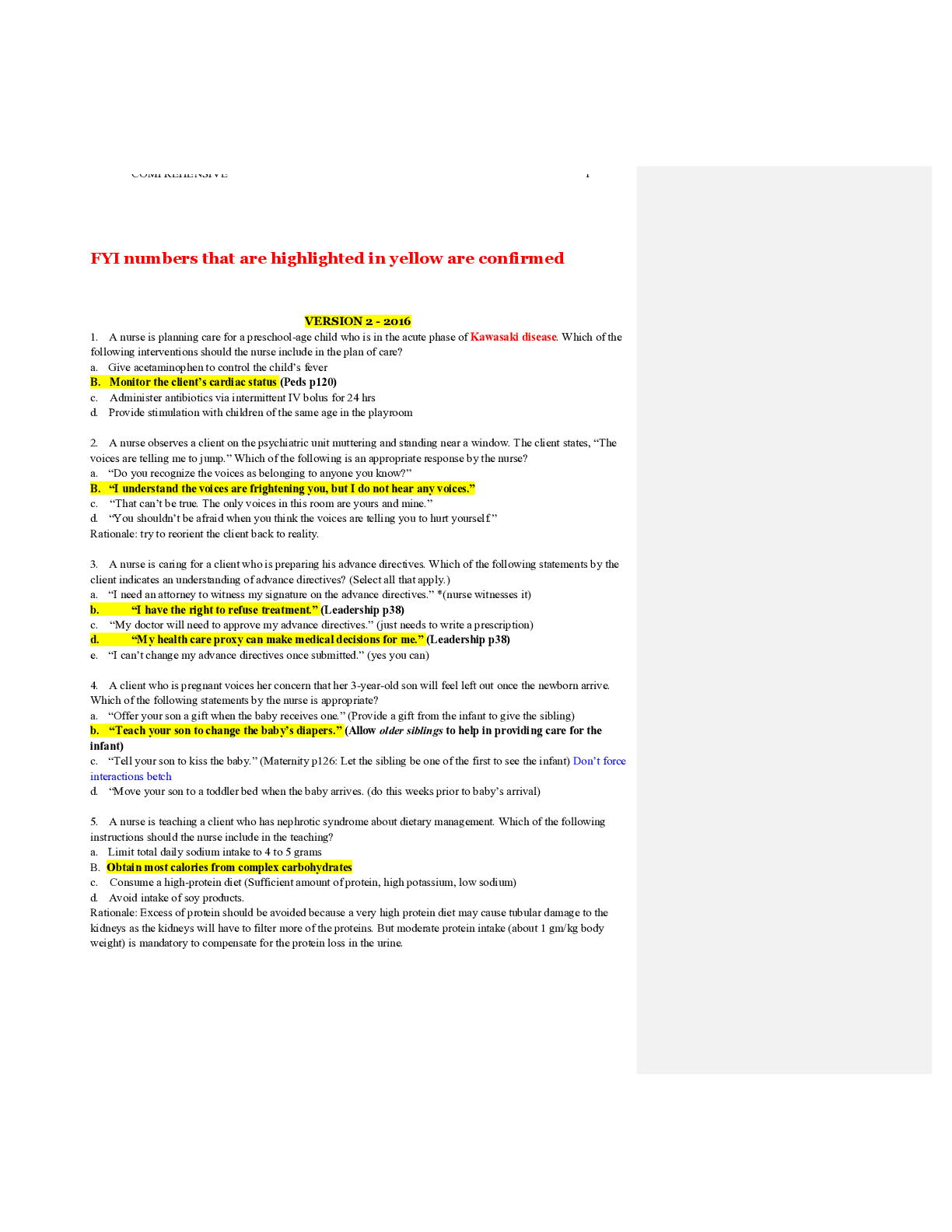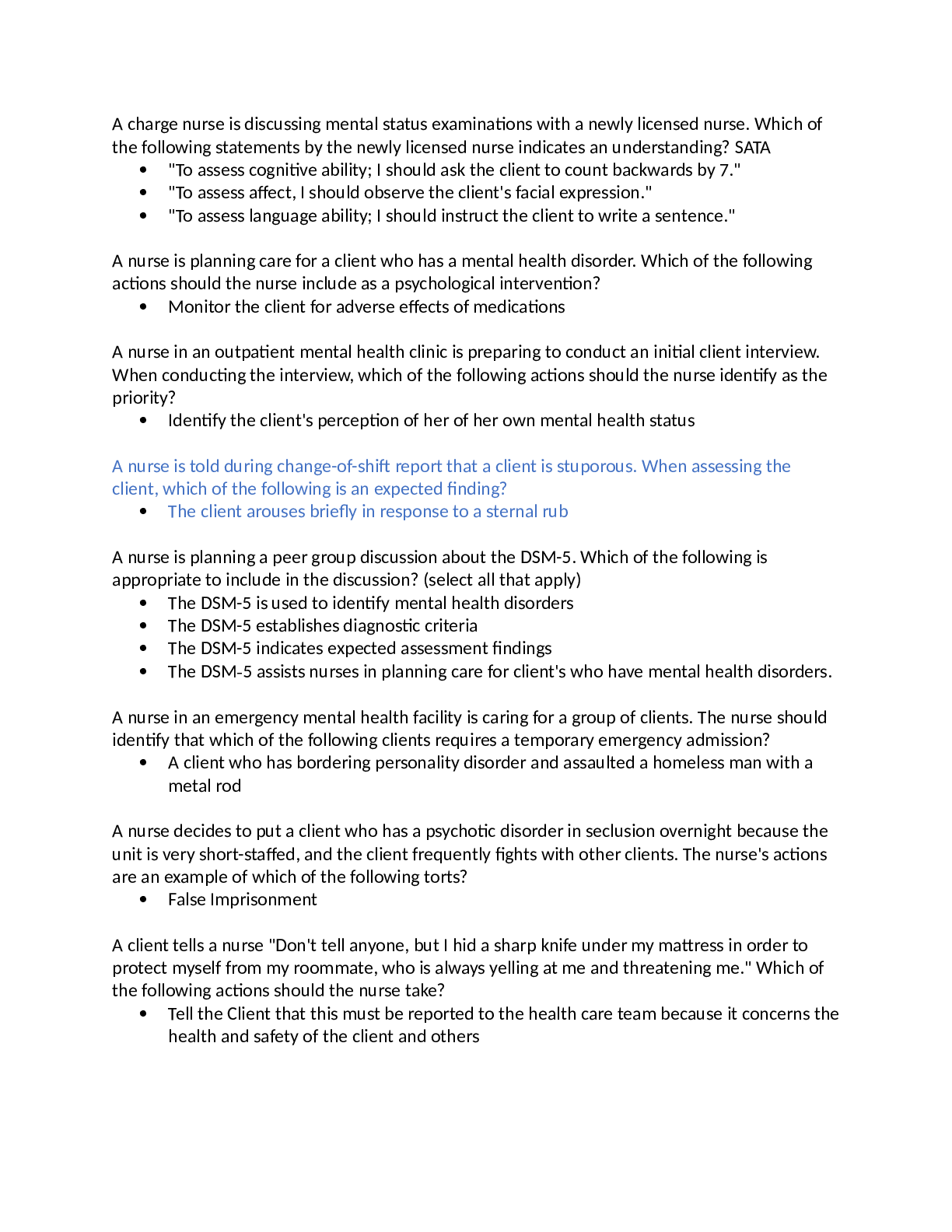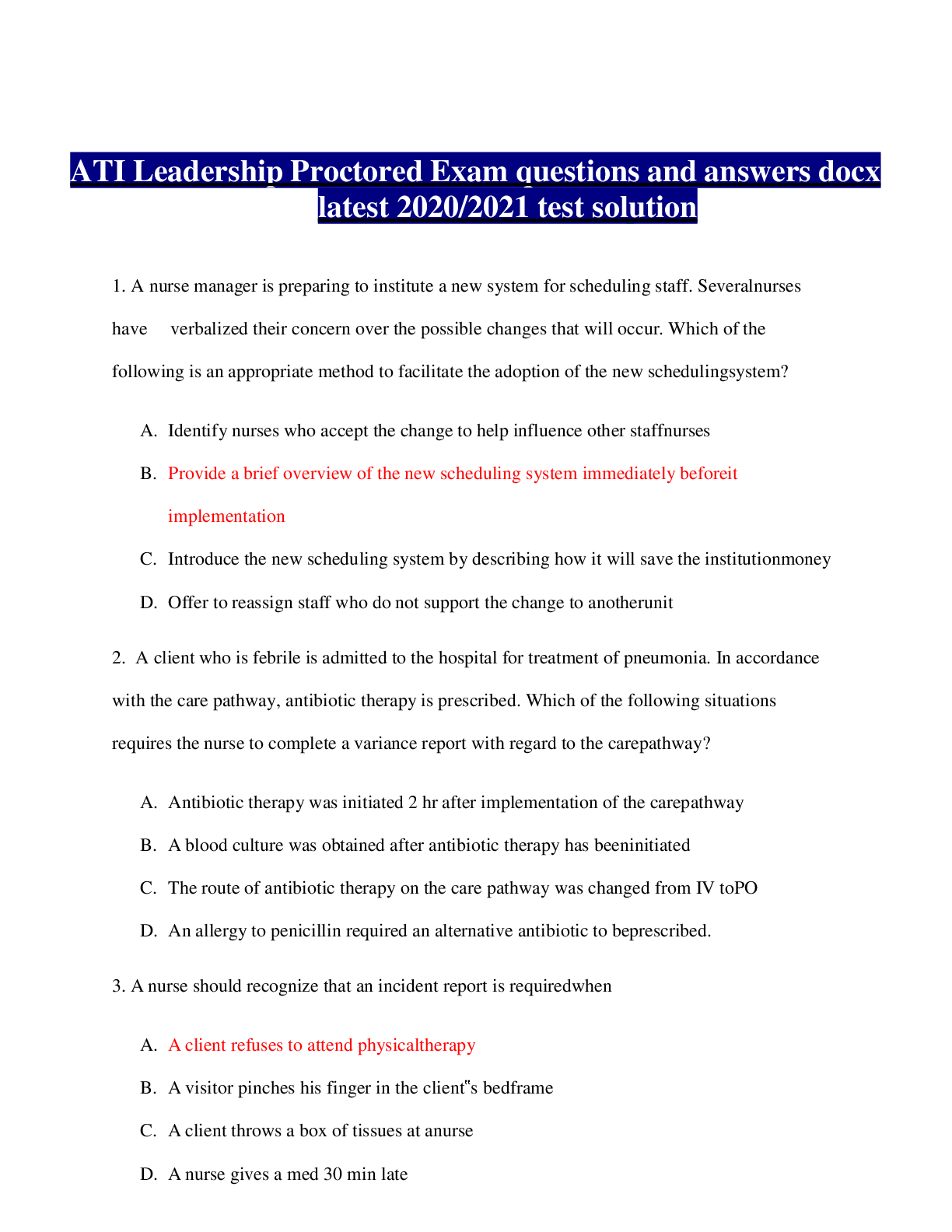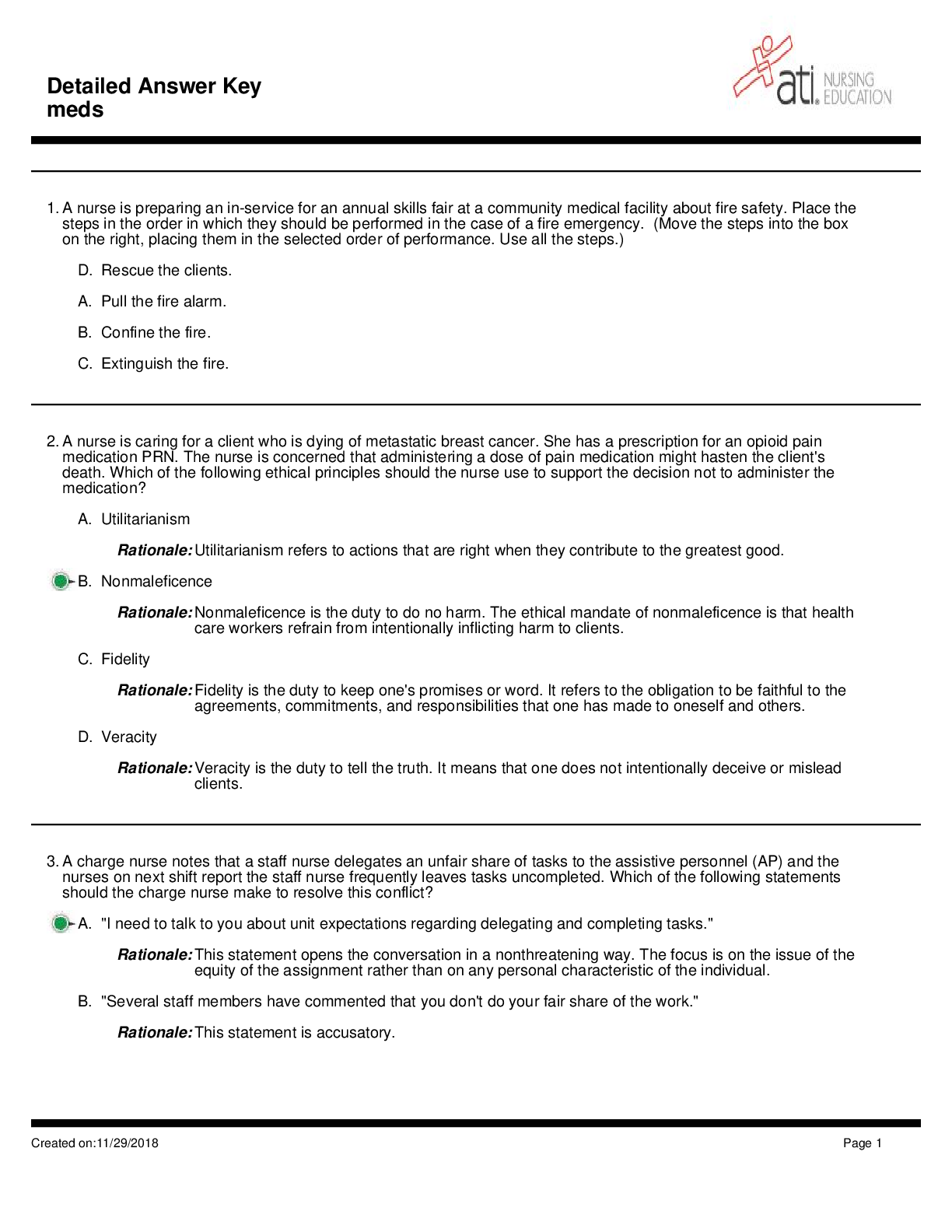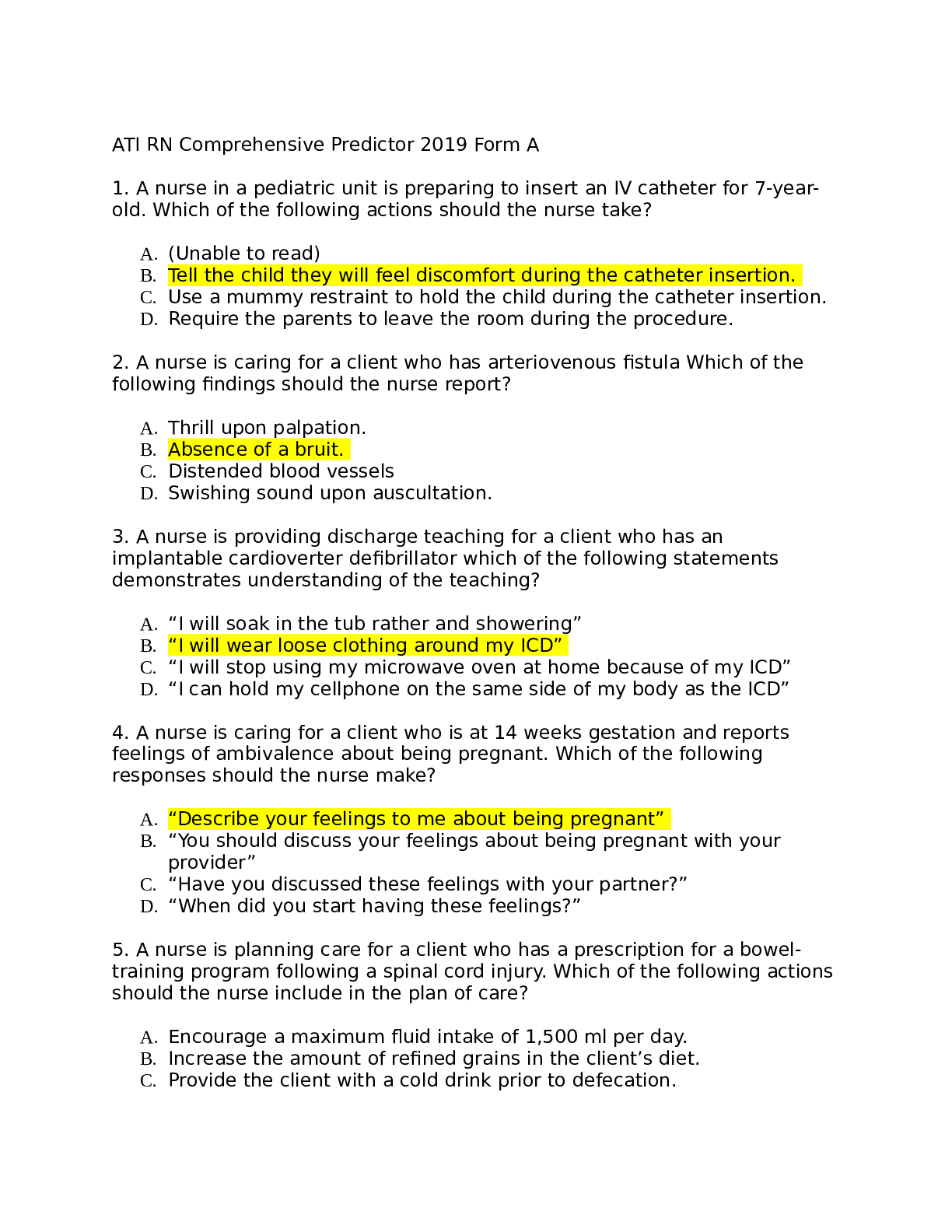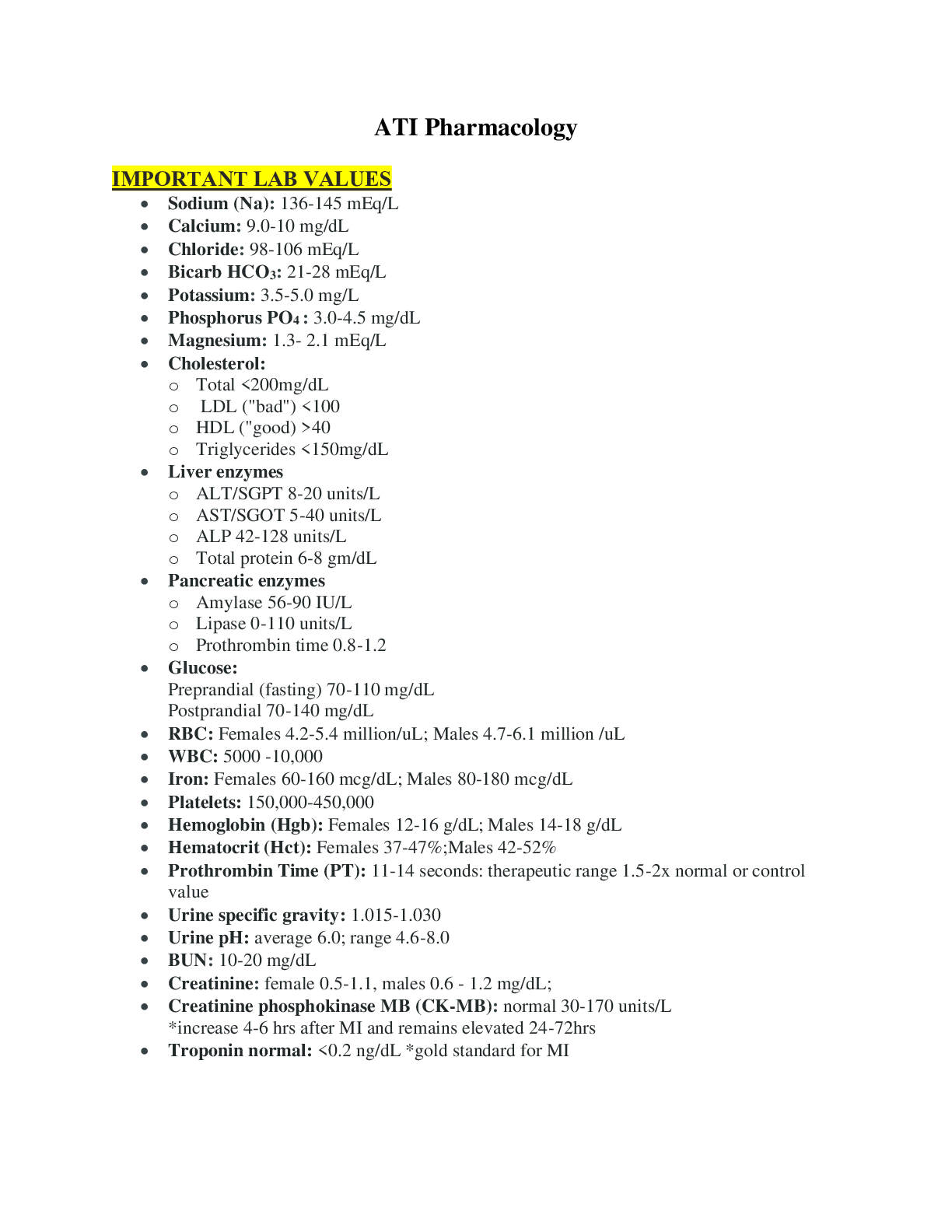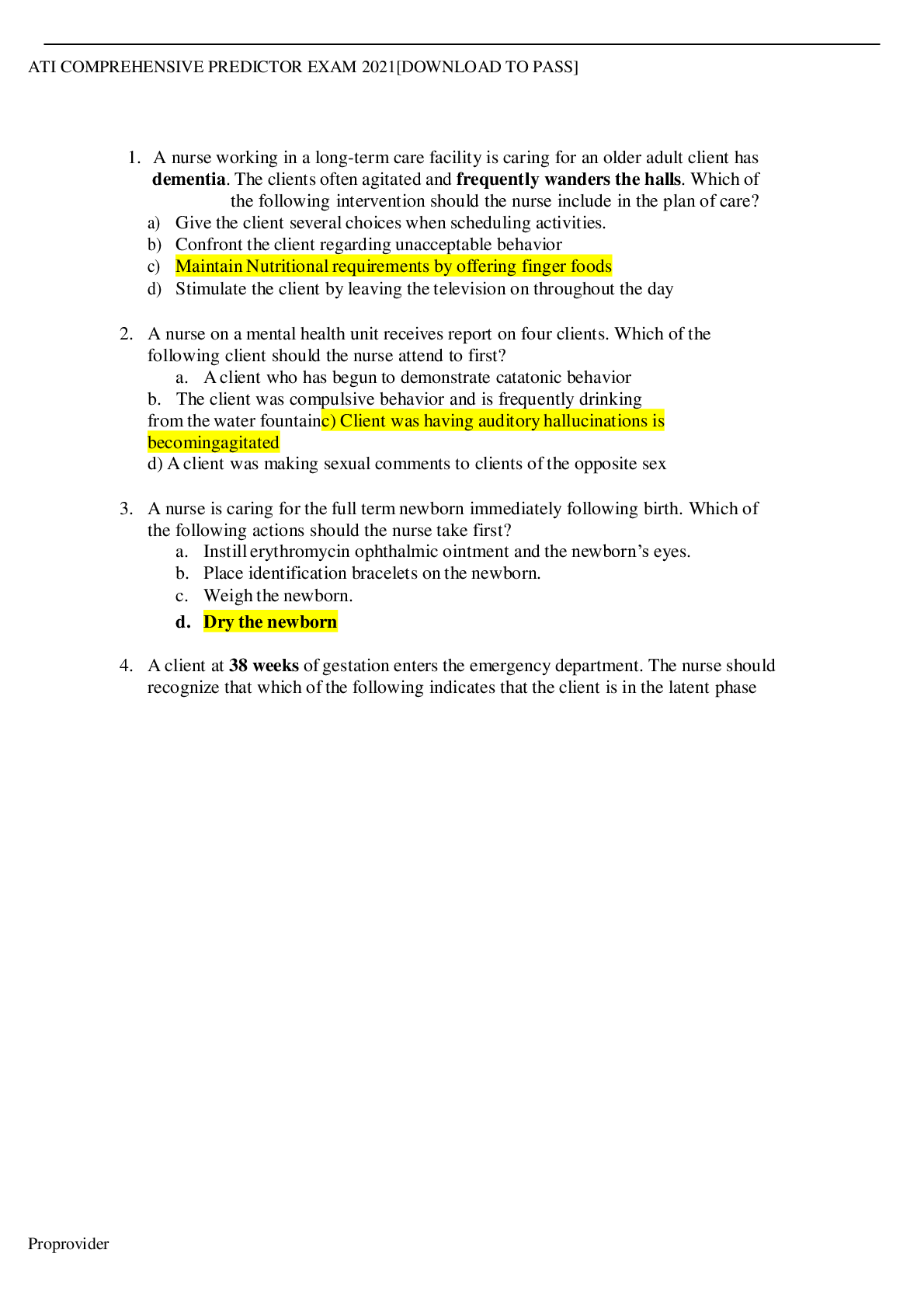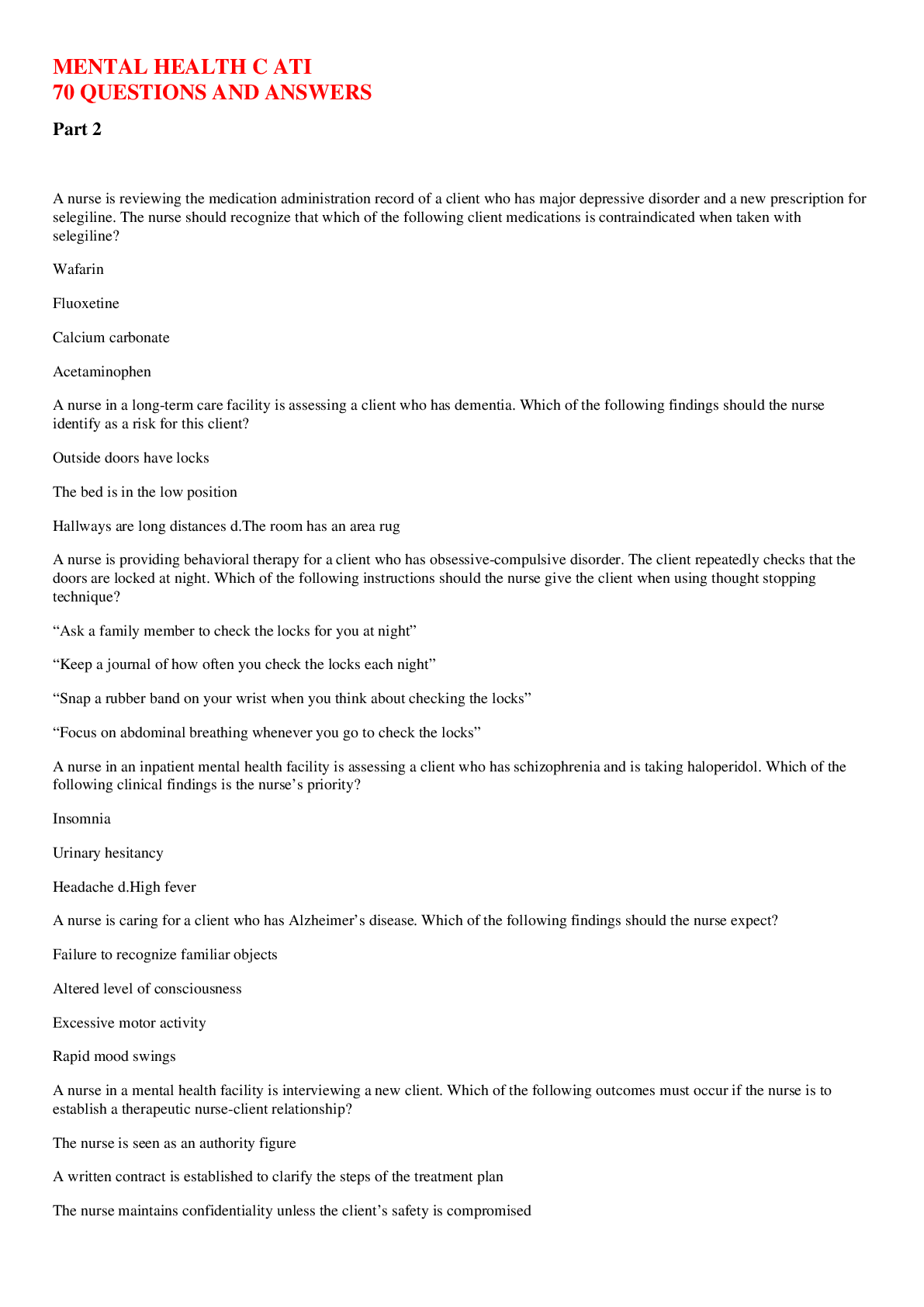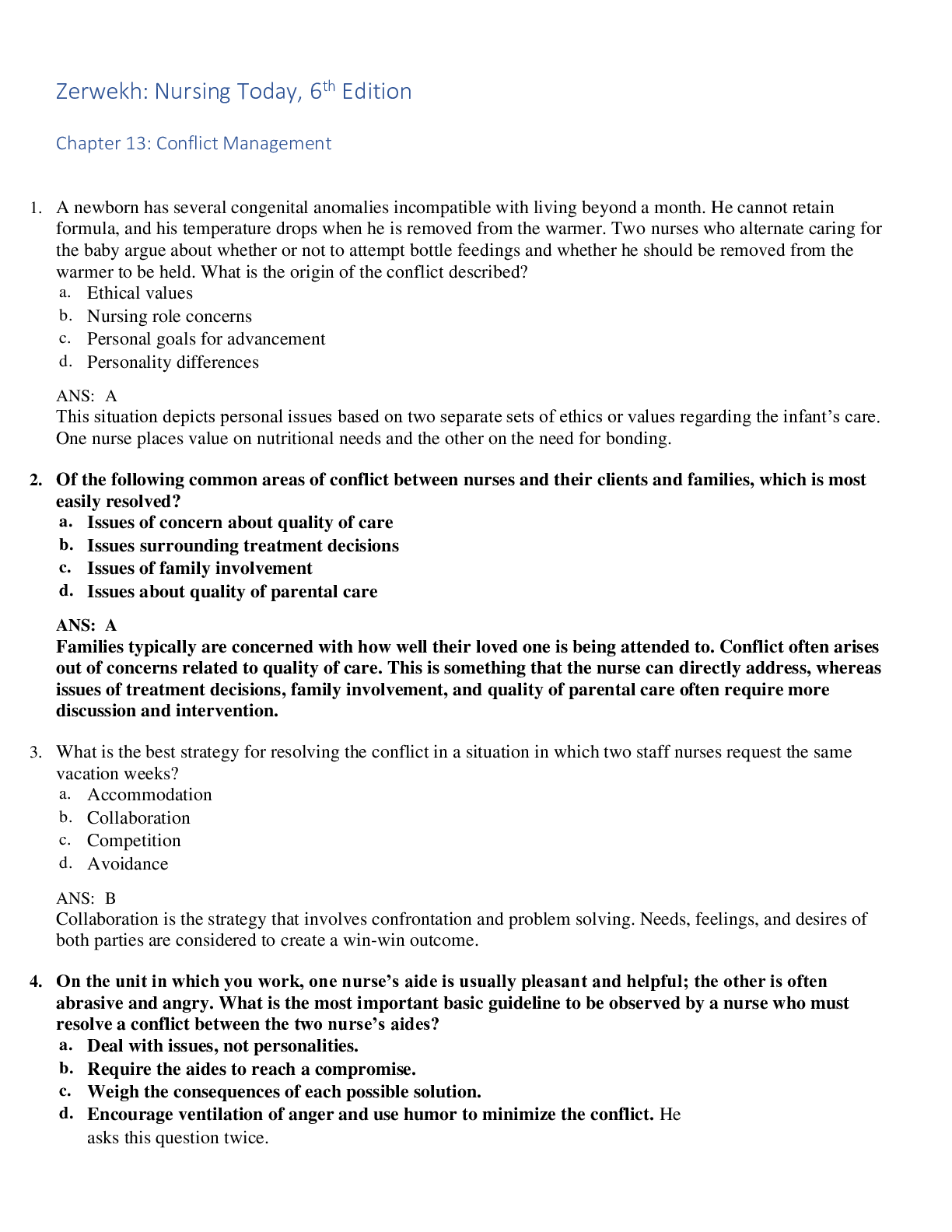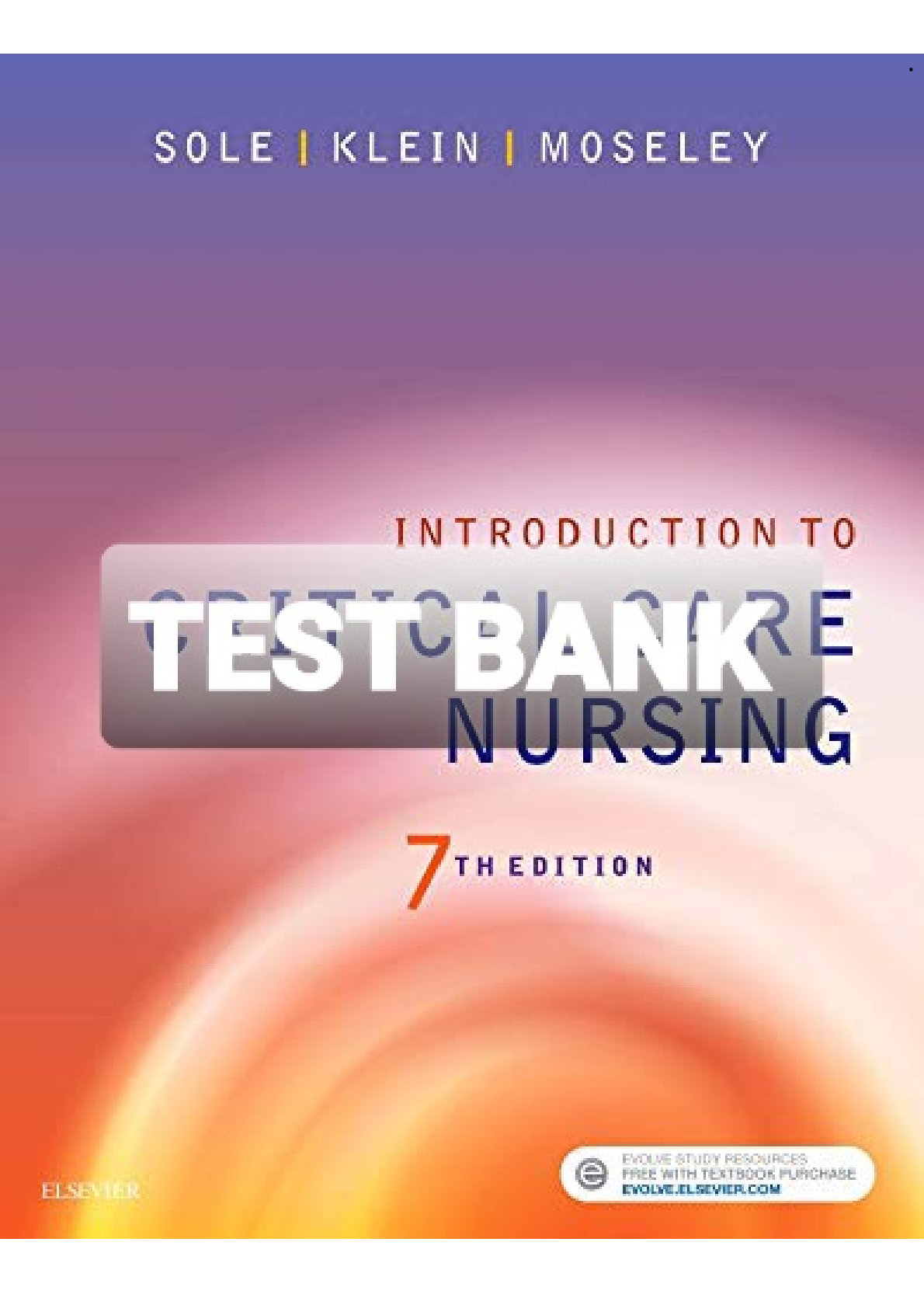*NURSING > QUESTIONS and ANSWERS > ATI pediatric nursing Exam 2020 Complete Questions and Answers_A+ guide. (All)
ATI pediatric nursing Exam 2020 Complete Questions and Answers_A+ guide.
Document Content and Description Below
ATI pediatric nursing Exam 2020 1. A nurse is assessing a 3-year-old child at a well-child visit. Which of the following should the nurse report to the provider? -Blood Pressure 88/46 mm Hg ... -Respirations 30/min -Urine specific gravity 1.018 mEq/L -Heart rate 110/min 2. A nurse is providing education to the family of a child who has juevenille idiopathic arthritis. Which of the following should the nurse include the teaching? -Limit the movement of large joints -Encourage the child to perform independent self-care -Provide the child with a soft mattress -Administer NSAIDs on an empty stomach 3. The mother of an adolescent tells a nurse that she argues frequently with her daughter about playing music while studying. Which of the following is an appropriate response for the nurse to make? -“Continue to discourage music because it is distracting.” -“Meet with your daughter’s teacher to discuss her study habits.” -“Encourage your daughter to join a peer study group.” -“Consider letting her make her own choice about listening to music while studying.” 4. A nurse is caring for a school-age child who was diagnosed with asthma and reports chest pain. Which of the following actions should the nurse take first? -Administer albuterol (Proventil) -Apply oxygen -Auscultate breath sounds -Notify the provider 5. A nurse is performing a urine dipstick test on a child who has nephrotic syndrome. Which of the following results should the nurse expect? -1+ nitrates -4+ protein -3+ ketones -2+ blood 6. A nurse is planning care for a toddler who has a serum lead level of 4 mcg/dL. Which of the following is an appropriate action for the nurse to take? -Instruct the parents to decrease the calcium in their toddler’s diet -Prepare the toddler for chelation therapy -Schedule the toddler for a yearly rescreening -Refer the family to child protective services 7. A nurse is caring for a child who has partial-thickness burns on more than 40% of his body. Which of the following fluids prescribed by the provider should the nurse administer to the child in the 24 hr? -5% dextrose -Lactated Ringer’s -Albumin -Plasmalyte 8. A nurse is caring for a child who has nephrotic syndrome. Which of the following findings is associated with this diagnosis? -Constipation -Hyperalbuminuria -Weight loss -Hypervolemia 9. A nurse is teaching a parent of a child who has Pediculosis. Which of the following statements from the parent indicates an understanding of the teaching? -“I should place nonwashable items in a bag for 5 days.” -“I will apply Benadryl ointment to the affected areas.” -“I will need to remove the nits after treatment.” -“I should apply permethrin cream each day for 7 days.” 10. A hospice nurse is visiting a parent on the 1-year anniversary of the death of his child from leukemia. Which of the following reactions by the parent would indicate to the nure the need for bereavement counseling referral? -The parent does not visit his child’s grave -The parent frequently looks through family photos -The parent has not returned to work -The parent seeks reassurance that he did everything possible 11. A nurse is admitting a 4-month-old infant who has heart failure to the cardiac unit. Which of the following findings is the highest priority? (Click on the “Exhibit” button below for additional client information. There are three tabs that contain separate categories of data.) -Three episodes of vomiting -Six wet diapers/24 hr -Weight 6.36 kg (14 lb) -Respiratory rate 30/min 12. A nurse is caring for a school-aged-child who is admitted with a poorly controlled seizure disorder. Which of the following should the nurse include in the plan of care? -Place a padded tongue blade at the child’s bedside -Maintain a well-lit room -Keep the head of the bed flat -Have oxygen available 13. A nurse is planning care for a child who has glomerulonephritis and is edematous. Which of the following activities should be part of the plan of care? -Monitor weekly weight -Restrict sodium intake -Administer IV bolus of 0/9% sodium chloride -Maintain bed rest 14. A charge nurse is preparing a room assignment for a school-age child. Which of the following is the most important consideration when planning a room assignment? -Length of stay -Disease process -Treatment schedule -Self-care ability 15. A nurse is providing teaching about growth hormone injections to the mother of a child who has growth hormone deficiency. Which of the following should the nurse include in the teaching? -Administer the injections intradermally -Store reconstituted medication at room temperature -Give the medication three times daily -Have serum calcium levels drawn periodically 16. A nurse is assessing a 4-year old child. Which of the following developmental milestones should the nurse expect? -Identifies right from left hand -Uses a utensil to spread butter -Cuts a shape using scissors -Draws a stick figure with seven body parts 17. During observation of children on a pediatric unit, a nurse notes a child begin to stare into space and grunt. The child’s extremities then begin to extend stiffly. In what order should the nurse perform the steps listed below? 1.Lower the child to the floor 2.Place a pillow under the child’s head 3.Loosen restrictive clothing 4.Assess the child’s mouth for injuries 18. A nurse is caring for a child who is postoperative following a tonsillectomy. Which of the following should the nurse recognize as a sign of hemorrhage? -Decreased pulse rate -Increased blood pressure -Frequent swallowing -Dark brown emesis 19. A nurse is providing care to a 13-month-old toddler following cleft palate repair. Which of the following interventions is appropriate for the nurse to take? -Avoid the use of elbow restraints on the client -Maintain the client in the supine position -Prevent the client from using a pacifier -Provide the client with a regular diet at time of discharge 20. A nurse is caring for a child who has a new diagnosis of Lyme disease. Which of the following is a manifestation of stage 1 of this disease? -Skin rash -Deafness -Memory Loss -Encephalopathy 21. A nurse is caring for a child who has epiglottitis. Which of the following actions should the nurse take? -Obtain a throat culture -Monitor oxygen saturation -Use a warm mist humidifier in the child’s room -Place the child in the supine position 22. A nurse is discussing food choices with the parent of a child who has celiac disease. Which of the following foods offered to the child by the parents is appropriate? -White bread -Oatmeal muffin -Barley soup -Rice pudding 23. A nurse is assessing a 7-month-old infant. Which of the following should the nurse report to the provider? -Inability to pull up from sitting to standing -Inability to crawl on hands and knees -Inability to respond to simple verbal commands -Inability to babble one-syllable sounds 24. A nurse is caring for a 3-year-old child who was administered pain medication. Which of the following pain scales is appropriate for measuring the client’s response to the medication? -Oucher -Numeric -Visual analog -Word-graphic 25. A school nurse is assessing a preschool-age child. Which of the following findings should the nurse identify as a potential finding of physical neglect? -Mismatched clothing -Separation anxiety -Bruises on her shins -Poor personal hygiene 26. A nurse is providing teaching to the parent of an infant who has diaper dermatitis. The nurse should teach the parent to apply which of the following to the affected area? -Zinc oxide -Antibiotic ointment -Talcum powder -Antiseptic solution 27. A nurse is assessing an infant who has heart failure. Which of the following findings should the nurse expect? -Weight loss -Bradycardia -Peripheral edema -Elevated blood pressure 28. A nurse at an urgent care clinic is performing an admission assessment on a child. Which of the following should the nurse recognize as an early manifestation of pertussis? -Inflammed throat with exudate -Purulent eye drainage -Dry, hacking cough -Koplik spots on buccal mucosa 29. A school-age child who was treated for a streptococcal throat infection is being admitted to the hospital with a diagnosis of acute rheumatic fever. Which of the following nursing interventions is appropriate? -Limit sodium intake -Restrict visitors -Maintain bed rest -Avoid salicylates 30. A nurse is caring for a child who is newly prescribed methotrexate (MTX). Which of the following should the nurse obtain prior to administering the first dose? -Arterial blood gasses -HbA1c -Liver function tests -Serum uric acid level 31. A nurse is teaching a parent of a child who is receiving IV famotidine (Pepcid). The nurse should tell the parent that which of the following is an adverse effect of famotidine? -Diaphoresis -Bruising -Hypotension -Hyperkalemia 32. A nurse in a pediatric unit is caring for a preschool-age child who has acute lymphocytic leukemia and severe stomatitis. Which of the following should the nurse include in the child’s plan of care? -Help the child brush her teeth gently with a soft sponge toothbrush -Administer oral viscous lidocaine -Clean the child’s mouth frequently with lemon glycerin swabs -Have the child swish with a hydrogen peroxide solution 33. A nurse is assessing a toddler who has diarrhea. Which of the following findings should alert the nurse to worsening dehydration? -Increased blood pressure -Elastic skin turgor -Urine output of 45 mL/hr -Decreased tear production 34. A nurse is performing a monthly assessment for a child who is taking methylphenidate (Ritalin). Which of the following is a symptom that indicates an adverse effect of the medication? -Mouth ulcers -Weight loss -Tachypnea -Oliguria 35. A school nurse is developing a plan of care for a student who is newly diagnosed with juvenile idiopathic arthritis (JIA). Which of the following should the nurse include in the plan? -Monitoring students for presence of communicable diseases -Administering opioids on a schedule during the school day -Ensuring appropriate use of splints during physical education class -Encouraging the student to choose high-calorie foods in the cafeteria 36. A nurse is caring for a preschool-age child who has been receiving IV fluids via a peripheral IV fluids via a peripheral IV catheter. When preparing to remove the IV fluids and catheter, which of the following steps should the nurse perform first? -Remove the tape -Turn off the pump -Occlude the tubing -Apply pressure over the insertion site 37. A nurse is caring for a child who is in Bryant traction. Which of the following is an appropriate action for the nurse to take? -Change the child’s position every 2 hr -Clean the pin sites with chlorhexidine every 4 hr -Maintain the hips at a 90 degree angle to the body -Ensure that the head of the bed is maintained at a 45 degree angle 38. A nurse is providing discharge about car seat use to the mother of a 6-month-old infant. Which of the following actions by the mother indicates a need for further teaching? -Securing the car seat using lower anchors and tethers instead of the seat belt -Positioning the car seat harmless just below the infant’s shoulders -Placing a rolled towel on one side of the infant’s head while traveling -Using a blanket as padding underneath the infant while traveling 39. A nurse is caring for an infant who has respiratory syncytial virus (RSV) and is in a mist tent. Which of the following actions should the nurse implement for infection control? -Ask the parents of the infant to bring bottles from home -Ensure that the infant is placed in a negative airflow room -Administer palvizumab (Synagis) as prescribed -Have a designated stethoscope in the room 40. A nurse is providing discharge teaching to the parent of an 18-month-old toddler who experienced dehydration. Which of the following statements by the parent should indicate to the nurse an understanding of the teaching? -“I will offer frequent, small amounts of fruit juice.” -“I will encourage my child to drink plain water.” -“I will monitor my child’s number of wet diapers.” -“I will check my child’s temperature once a day.” 41. A nurse is assessing a child who has appendicitis with possible perforation. The nurse should identify which of the following as a manifestation of peritonitis? -Hyperactive bowel sounds -Abdominal distention -Bradycardia -Polyuria 42. A nurse is preparing an in-service on a child maltreatment for a group of newly licensed nurses. Which of the following should the nurse as a manifestation of physical abuse? -Recurrent urinary tract infections -Symmetric burns of the lower extremities -Growth failure -Lack of subcutaneous fat 43. A nurse is caring for a 6-year-old child who is receiving chemotherapy. Which of the following laboratory values should the nurse report to the provider? -Hemoglobin 9.0 g/dL -WBC count 9,500/mm3 -Hematocrit 40% -Platelet count 300,000/mm3 44. A nurse is caring for a newborn who has a large sacral myelomeningocele. Prior to surgery, the nurse should prevent potential complications by -Maintaining the newborn in a supine position -Securing the newborn’s diaper loosely -Keeping the newborn’s legs abducted with a pad between the knees -Covering the newborn’s unrepaired sac with a dry, adherent dressing 45. A nurse is caring for a child following surgery for an acute perforated appendix. Which of the following is an expected finding in the immediate postoperative period? -Purulent nasogastric drainage -Absence of peristalsis -Pain at McBruney’s point -A WBC count of 6,000/mm3 46. A nurse is planning care for a child following the application of a halo brace. Which of the following interventions should the nurse include in the plan of care? -Apply pressure to the device when repositioning -Perform active range of motion of the head and neck -Adjust the device when bathing -Provide pin site care 47. A nurse is caring for an infant who is postoperative pyloric stenosis repair. Which of the following is an appropriate action for the nurse to take? -Educate the parent about gastrostomy care -Maintain stomach decompression with nasogastric suction -Thicken the infant’s formula with rice cereal -Monitor the infant following feedings for vomiting 48. A nurse is caring for a toddler who has a foreign body aspiration. Which of the following is an appropriate action for the nurse to take? -Prepare for an endoscopy -Perform chest percussion -Administer a bronchodilator -Obtain a sputum culture 49. A nurse is teaching an adolescent about how to manage tinea pedis. Which of the following statements from the client indicates an understanding of the teaching? -“I will apply bacitracin ointment between my toes daily.” -“I should wear sandals as much as possible.” -“I should wear wool socks with my boots.” -“I will clean the lesions with Betadine solution.” 50. A nurse is providing teaching to the parent of child who has impetigo. Which of the following instructions should the nurse include in the teaching? -Administer oral antiviral medications for 3 weeks -Apply 1% topical antifungal medication to affected areas -Cleanse area with hydrogen peroxide daily -Remove crust after soaking with 1:20 Burow’s solution 51. A nurse is caring for an adolescent undergoing a lumbar puncture. Which of the following results would confirm a diagnosis of bacterial meningitis? -Decreased CSF pressure -Decreased WBCs -Increased protein -Increased glucose 52. A nurse is educating the parents of a toddler who will be discharged with a lower leg cast. The nurse should instruct the family that which of the following findings is important to report to the provider? -Pruritus underneath the cast -Inability to move the toes -Swelling of the toes when the leg is dependent -Toes that feel warm to the touch 53. A nurse is teaching an adolescent who has a new diagnosis of infectious mononucleosis. Which of the following client statements indicates an understanding of the teaching? -“I will need to be on antibiotics for 14 days.” -“I should take ibuprofen for my headaches.” -“I can play in the football game this weekend.” -“I will need to stay out of school for 6 weeks.” 54. A nurse is caring for a school-age child who has heart disease and have developed heart failure. Which of the following interventions should the nurse include in the plan of care? -Provide small, frequent meals -Schedule time in the play room for the child -Weigh the child weekly -Perform hygiene activities for the child 55. A nurse is assessing a 6-month-old infant at a well-infant visit. Which of the following findings should the nurse report to the provider? -Presence of strabismus -Presence of corneal light reflex -Presence of open anterior fontanel -Presence of cerumen 56. A nurse is caring for a child who has nephrotic syndrome. Which of the following assessments should the nurse perform to confirm peripheral edema? -Palpating dorsum of feet -Weighing the child daily -Measuring the child’s skin turgor -Observing for periorbital swelling 57. A nurse is working with a toddler who has cerebral palsy and is having trouble with verbal communication. Which of the following strategies should the nurse plan to use to promote effective communication? (Select all that apply) -Use pictures and objects when talking to the child -Encourage the child to move his lips and tongue when eating -Speak to the child in a louder voice -Allow the child time to articulate at his own pace -Discourage the child’s use of voice-assistive equipment 58. A nurse is auscultating a child’s pneumonia. What did she hear? A nurse is preparing to administer cefazolin (Ancef) 25 mg/kg IV bolus to a school-age child who weighs 55 lbs. Available is cefazolin injection 330 mg/mL. How many mL should the nurse administer per dose? [Show More]
Last updated: 1 month ago
Preview 1 out of 12 pages
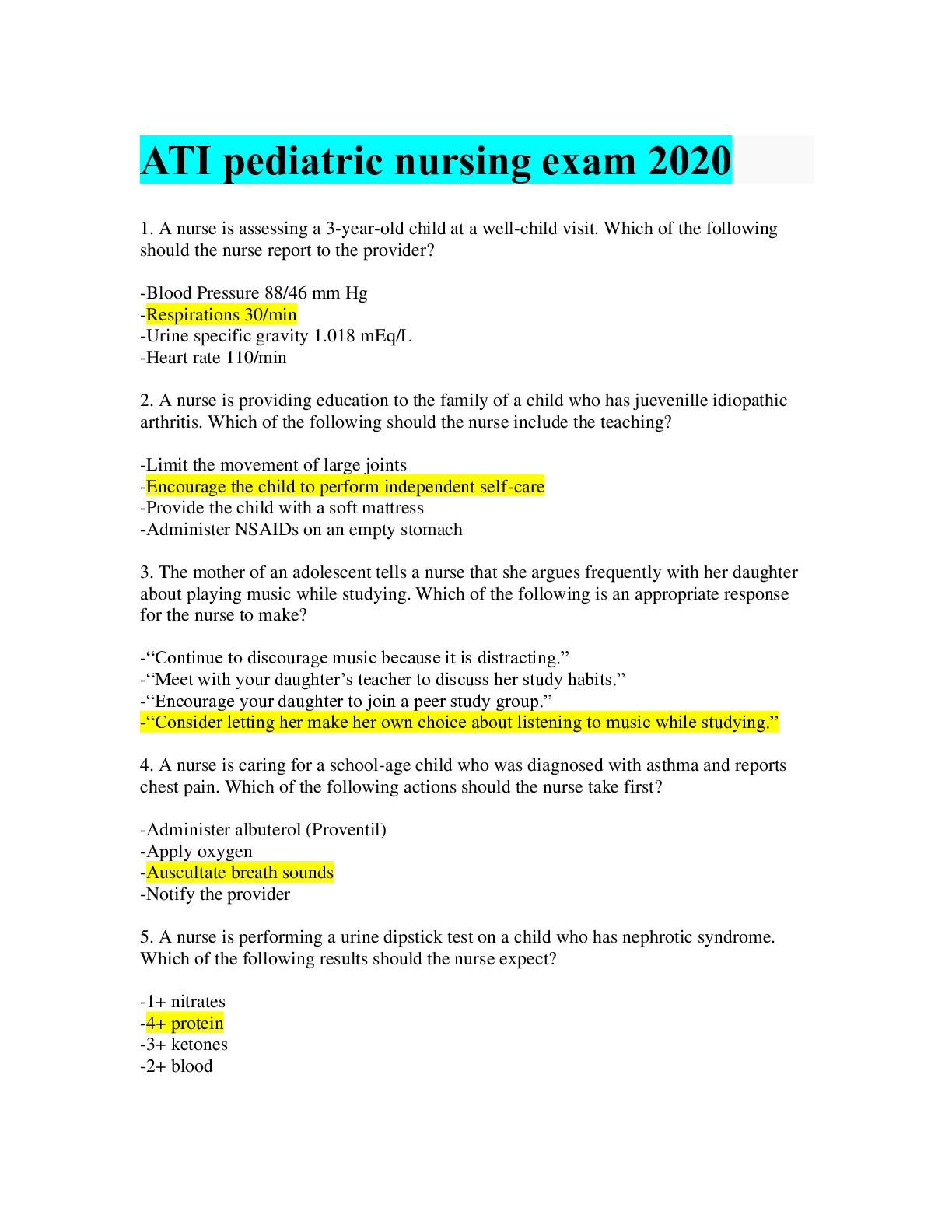
Reviews( 0 )
Document information
Connected school, study & course
About the document
Uploaded On
Sep 23, 2020
Number of pages
12
Written in
Additional information
This document has been written for:
Uploaded
Sep 23, 2020
Downloads
1
Views
158


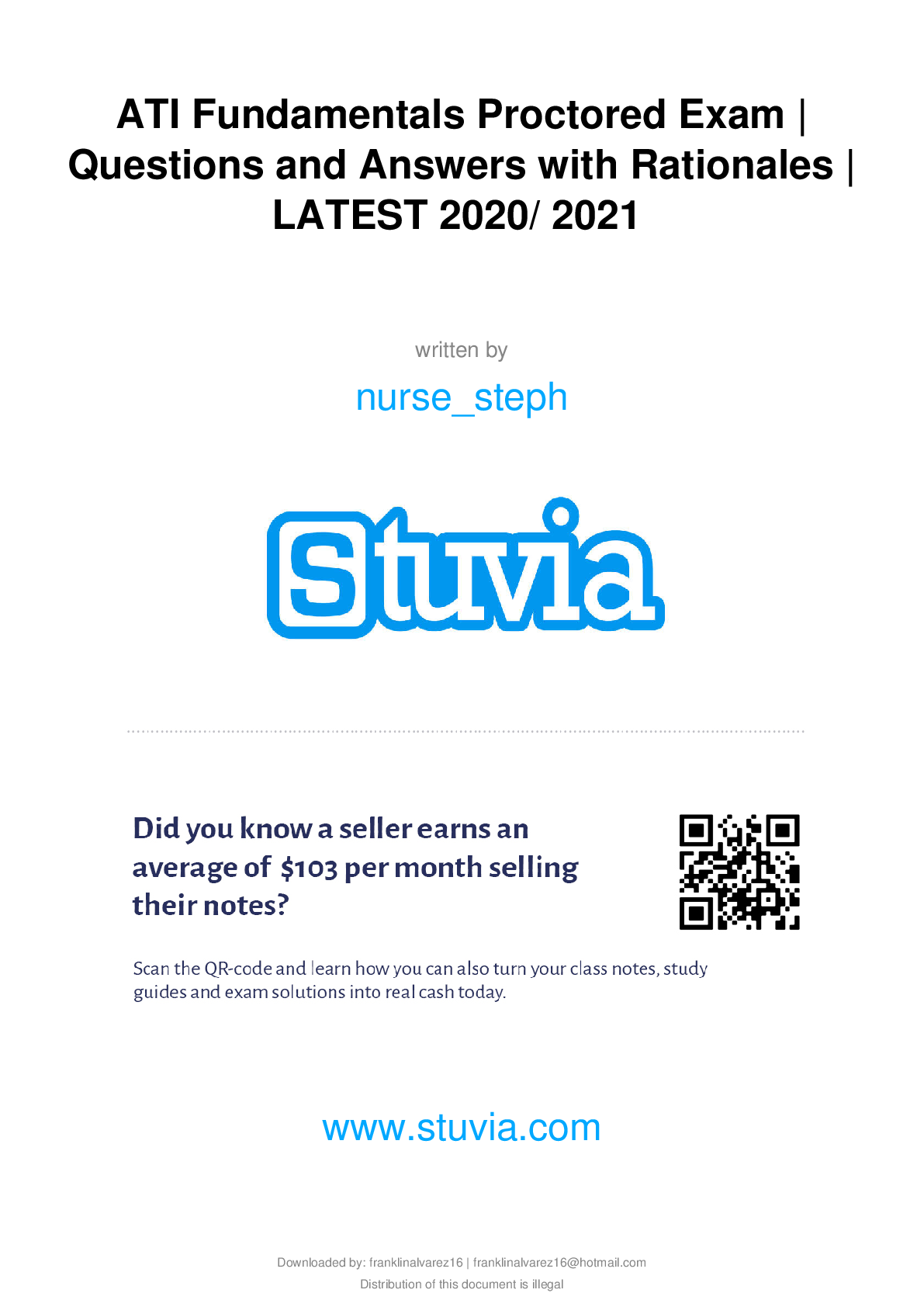
.png)
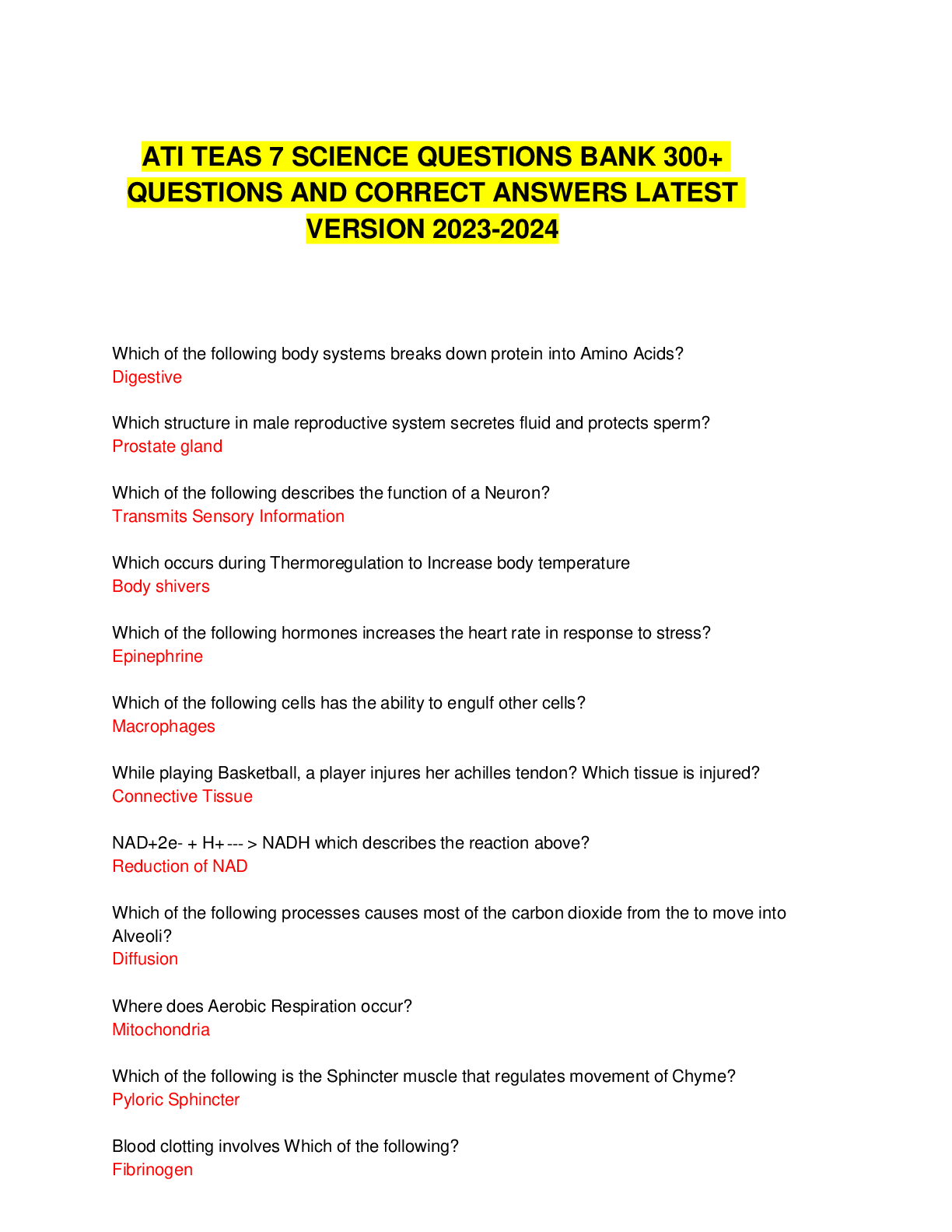
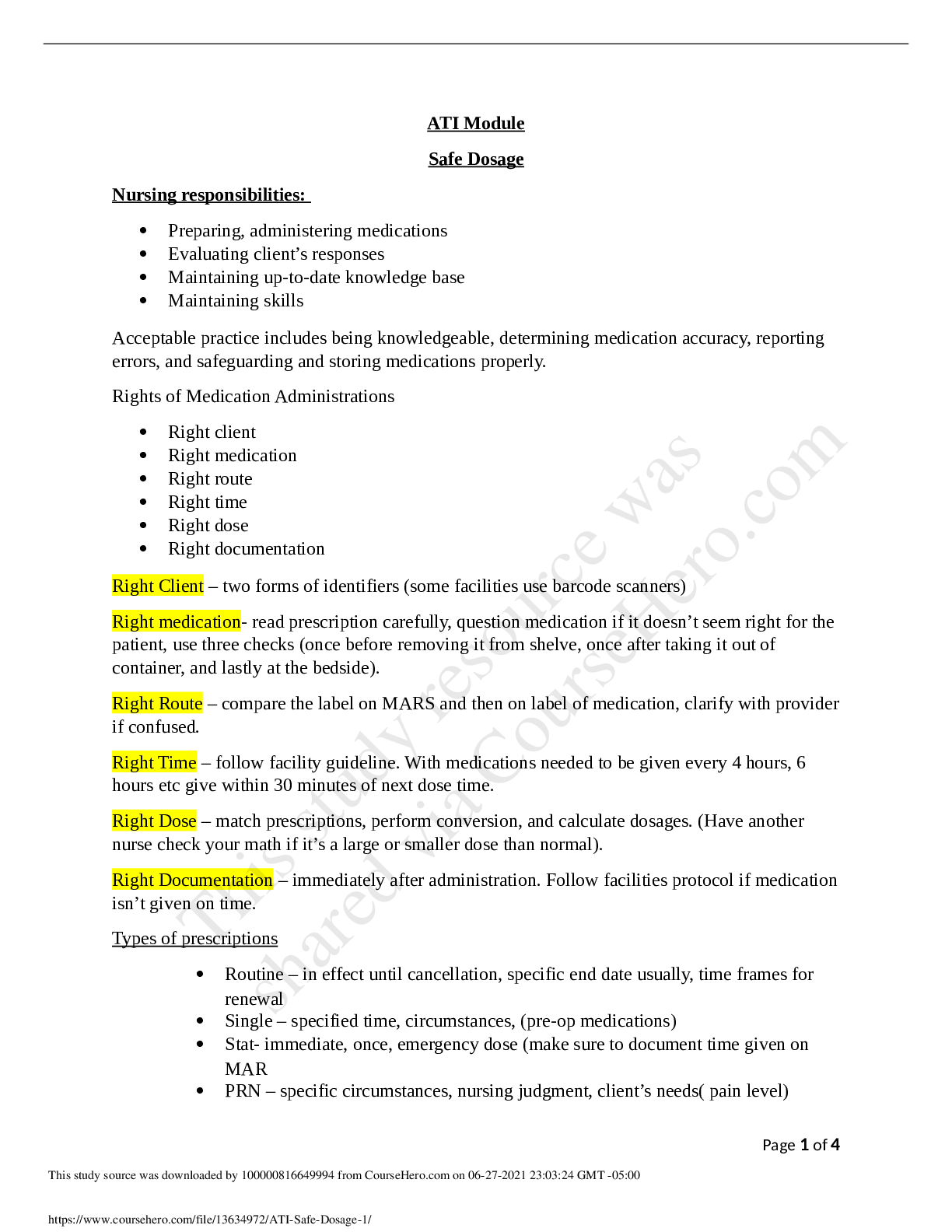
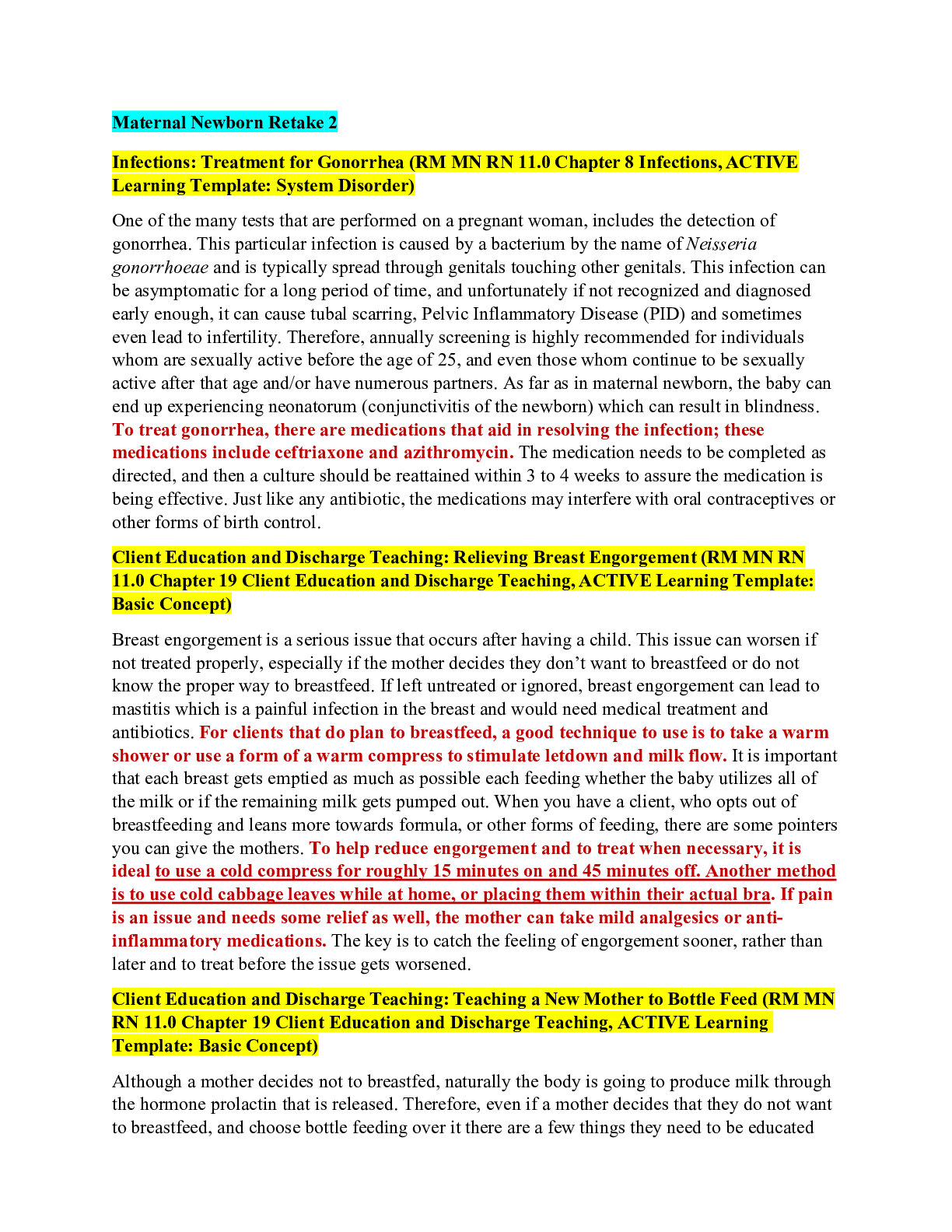
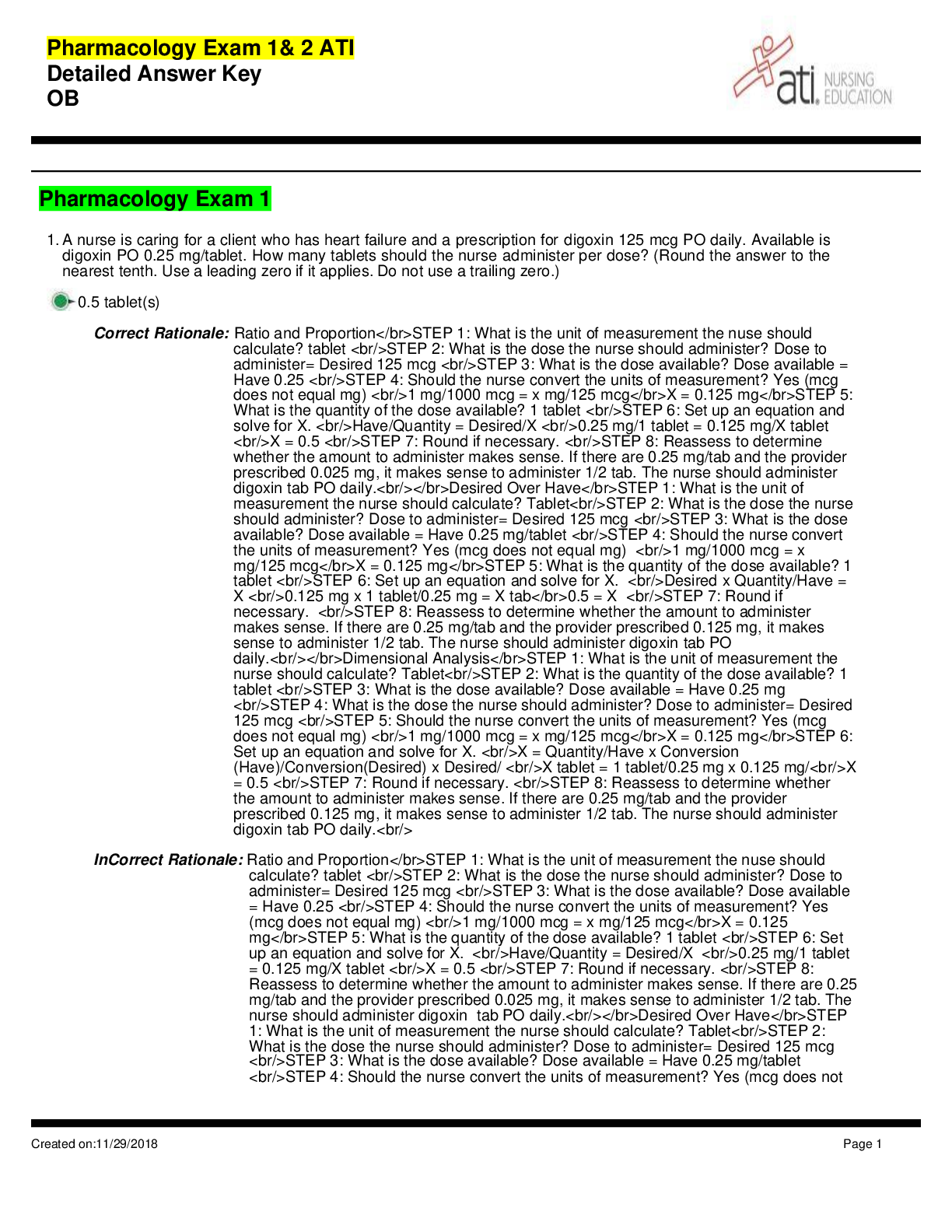
.png)
Perop.png)
